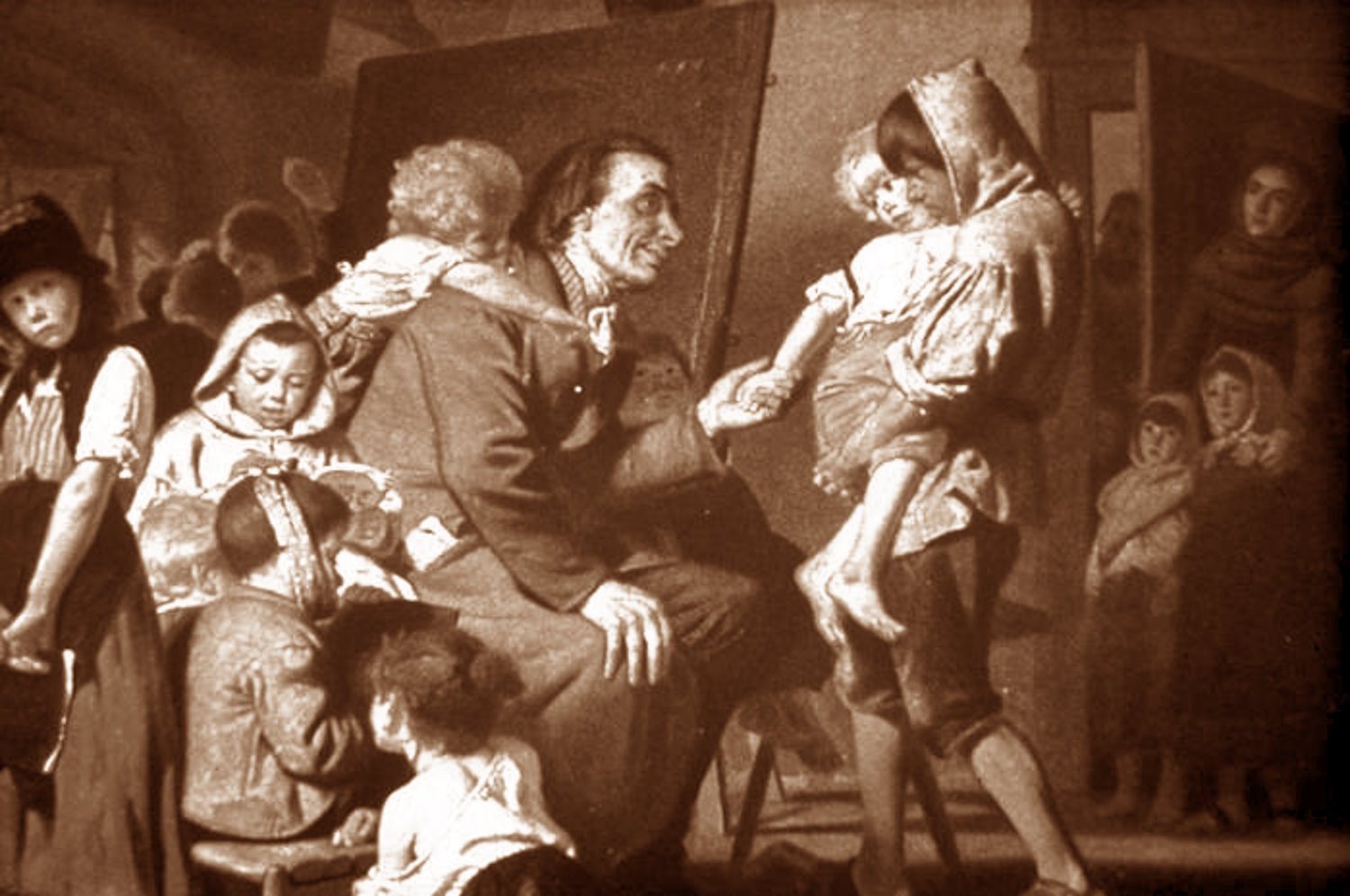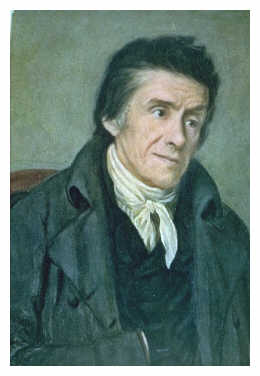 Johann Heinrich Pestalozzi: pedagogy, education and social justice. His commitment to social justice, interest in everyday forms and the innovations he made in schooling practice make Pestalozzi a fascinating focus for study.
Johann Heinrich Pestalozzi: pedagogy, education and social justice. His commitment to social justice, interest in everyday forms and the innovations he made in schooling practice make Pestalozzi a fascinating focus for study.
Johann Heinrich Pestalozzi (1746 – 1827). Born in Zurich, Pestalozzi took up Rousseau’s ideas and explored how they might be developed and implemented. His early experiments in education (at Neuhof) ran into difficulties but he persisted and what became known as the ‘Pestalozzi Method’ came to fruition in his school at Yverdon (established in 1805). Instead of dealing with words, he argued, children should learn through activity and through things. They should be free to pursue their own interests and draw their own conclusions (Darling 1994: 18).
I wish to wrest education from the outworn order of doddering old teaching hacks as well as from the new-fangled order of cheap, artificial teaching tricks, and entrust it to the eternal powers of nature herself, to the light which God has kindled and kept alive in the hearts of fathers and mothers, to the interests of parents who desire their children grow up in favour with God and with men. (Pestalozzi quoted in Silber 1965: 134)
Pestalozzi goes beyond Rousseau in that he sets out some concrete ways forward – based on research. He tried to reconcile the tension, recognized by Rousseau, between the education of the individual (for freedom) and that of the citizen (for responsibility and use). He looks to ‘the achievement of freedom in autonomy for one and all’ Soëtard 1994: 308).
His initial influence on the development of thinking about pedagogy owes much a book he published in 1801: How Gertrude Teaches Her Children – and the fact that he had carried his proposals through into practice. He wanted to establish a ‘psychological method of instruction’ that was in line with the ‘laws of human nature. As a result he placed a special emphasis on spontaneity and self-activity. Children should not be given ready-made answers but should arrive at answers themselves. To do this their own powers of seeing, judging and reasoning should be cultivated, their self-activity encouraged (Silber 1965: 140). The aim is to educate the whole child – intellectual education is only part of a wider plan. He looked to balance, or keep in equilibrium, three elements – hands, heart and head.
Exhibit 1: William H. Kilpatrick summarization of the six principles that run through Pestalozzi’s efforts around schooling
Personality is sacred. This constitutes the ‘inner dignity of each individual for the young as truly as for the adult.
As ‘a little seed… contains the design of the tree’, so in each child is the promise of his potentiality. ‘The educator only takes care that no untoward influence shall disturb nature’s march of developments’.
Love of those we would educate is ‘the sole and everlasting foundation’ in which to work. ‘Without love, neither the physical not the intellectual powers will develop naturally’. So kindness ruled in Pestalozzi’s schools: he abolished flogging – much to the amazement of outsiders.
To get rid of the ‘verbosity’ of meaningless words Pestalozzi developed his doctrine of Anschauung – direct concrete observation, often inadequately called ‘sense perception’ or ‘object lessons’. No word was to be used for any purpose until adequate Anschauung had preceded. The thing or distinction must be felt or observed in the concrete. Pestalozzi’s followers developed various sayings from this: from the known to the unknown, from the simple to the complex, from the concrete to the abstract.
To perfect the perception got by the Anschauung the thing that must be named, an appropriate action must follow. ‘A man learns by action… have done with [mere] words!’ ‘Life shapes us and the life that shapes us is not a matter of words but action’.
Out of this demand for action came an emphasis on repetition – not blind repetition, but repetition of action following the Anschauung.
William H. Kilpatrick in his introduction to Heinrich Pestalozzi (1951) The Education of Man – Aphorisms, New York: Philosophical Library.
And what is his significance to educators today? First, there is his concern with social justice and his commitment to work with those who have suffered within society. He saw education as central to the improvement of social conditions
Second, he used his sympathy for peasant life and his remembrance of his mother’s care as paradigms – as ways of thinking about the form education should take. In a famous phrase he declared: ‘ There can be no doubt that within the living room of every household are united the basic elements of all true human education in its whole range’. This underlines the potential of everyday life for educators. That said though, Pestalozzi made a significant contribution to the establishment of the school as a central educational force (in contrast to Rousseau’s emphasis on the tutor).
Third, there is Pestalozzi’s concern with equilibrium between elements – head, hands and heart – and the dangers of attending to just one.
Fourth, Pestalozzi is a classic example of the ‘reflective practitioner’. He is concerned with action, with experimentation and yet, at the same time, he is committed to observation and reflection, and to trying to make sense of experiences and situations.
Fifth, in his failed experiment at Neuhof he attempted to a form of schooling that has subsequently appealed to Gandhi and others concerned with combating colonialism and its legacy. He wanted the school to combine education with work. The school was to be a production unit so that children could finance their own learning – and in so doing they would be under no obligation to anyone. Furthermore, the school could be free from state interference.
Last, and not least, he strove to combat the tyranny of method and ‘correctness’. It is ironical that his approach should become known as a method; and that observers attempted to systematize his thought. It was his commitment to people and their well-being that animated his life’s work – and in Aristotle’s terms he would put that which is ‘right’ or good before that which is ‘correct’.
Further reading and references
Key texts: the ‘classic’ Pestalozzi text on education is:
Pestalozzi, J. H. (1894) How Gertrude Teaches her Children translated by Lucy, E. Holland and Frances C. Turner. Edited with an introduction by Ebenezer Cooke. London: Swan Sonnenschein. A new translation by Michel Soëtard should, hopefully, appear in the near future.
Unfortunately, it is difficult to get hold of his other work in English – other than through edited collections and collections of aphorisms.
Biographical material: the standard English language treatment is:
Silber, K. (1965) Pestalozzi.: The man and his work 2e, London: Routledge and Kegan Paul.
Michel Soëtard provides a good introduction to his work in Zaghloul Morsy (ed) (1994) Thinkers on Education Volume 3, Paris: UNESCO Publishing.
Exploration of his contribution: For a good overview of his educational philosophy in practice see:
Brühlmeier, A. (2010). Head, Heart and Hand. Education in the spirit of Pestalozzi. Cambridge: Sophia Books.
References
Oelkers, Jürgen & Osterwalder, Fritz (Hg.) (1995). Pestalozzi — Umfeld und Rezeption. Studien zur Historisierung einer Legende. Weinheim: Beltz
Osterwalder, Fritz (1996). Pestalozzi — ein pädagogischer Kult. Weinheim: Beltz
Stadler, Peter (1988/1993). Pestalozzi. Geschichtliche Biographie (zwei Bände). Zürich: NZZ
Tröhler, Daniel (2006). Republikanismus und Pädagogik. Pestalozzi im historischen Kontext. Bad Heilbrunn: Klinkhardt
Tröhler, Daniel (2008). Johann Heinrich Pestalozzi. Bern: Haupt Verlag.
Websites: unfortunately all the interesting pages are in French or German. I am still trying to find some good English language pages.
Acknowledgements: Opening image: Pestalozzi with orphans at Stans – the original picture was by Konrad Grob (1828 – 1904), Public domain, via Wikimedia Commons. The second picture of Johann Heinrich Pestalozzi: Painter: probably F.G.A. Schöner. There is an oil painting done after this painting by Francesco Ramos in the late 18th century/early 19th century that is shown today in the Museo del Prado in Madrid. This image (or other media file) was retrieved from Wikimedia Commons and is said to be in the public domain because its copyright has expired. http://en.wikipedia.org/wiki/File:Johann_Heinrich_Pestalozzi.jpg
© Mark K. Smith 1996, 2008
How to cite this piece: Smith, M. K. (1996, 2008). Johann Heinrich Pestalozzi: pedagogy, education and social justice, The encyclopedia of pedagogy and informal education. [https://infed.org/mobi/johann-heinrich-pestalozzi-pedagogy-education-and-social-justice/. Retrieved: insert date].

